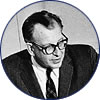Eero Saarinen
1910–1961
MArch 1934 |

|
Horizontal expansiveness and idealized geometric shapes mark such Saarinen classics as the Jefferson Westward Expansion Memorial (the St. Louis arch beside the Mississippi) and Dulles International Airport. His glass-and-steel structures for the General Motors Technical Center (Warren, Michigan) or the IBM buildings in Minnesota and in Yorktown, New York, set a prevailing mode for late-20th-century commerce and industry. Gravity-defying concrete experiments like the TWA terminal at John F. Kennedy Airport or the MIT auditorium were nearly as influential, demonstrating the architect’s dedicated search for forms appropriate to both the function and the spirit of a building.
Saarinen’s father, a Finnish architect, had moved the family to the United States when the boy was in his early teens. Intending to be a sculptor, Eero created successful furniture designs and later approached buildings with a sculptor’s eye and sense of organic unity.
Many Saarinen works were executed posthumously after he succumbed at 51 to brain cancer. He drew on a classicist Yale training, plus European influences (especially Mies van der Rohe), and a strong formalism that continued the Modernist, International, objectivist school.
Saarinen is represented in New York City by the CBS skyscraper and the Vivian Beaumont Theater at Lincoln Center. But he worked less in urban centers than on corporate and university campuses. “Universities,” he remarked, “are the oases of our desert-like civilization.they are the only beautiful, respectable pedestrian places left.” He contributed to such “oases” as MIT, Drake, Vassar, and the University of Pennsylvania. At Yale, he designed Ezra Stiles and Morse colleges and the “whale,” Ingalls Rink.

